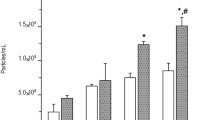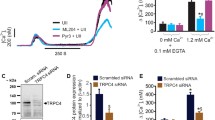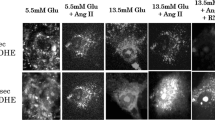Summary
Accumulation of extracellular matrix in the mesangium and altered renal eicosanoid synthesis are two prominent features of diabetic glomerular disease. We investigated the relationship between eicosanoid and extracellular matrix production in rat mesangial cells cultured under high glucose vs normal glucose conditions. Long-term exposure of rat mesangial cells to high glucose, but not to iso-osmolar mannitol, significantly increased extracellular matrix accumulation and gene expression and transforming growth factor-Β (TGF-Β) mRNA levels, and decreased prostaglandin (PG) E2 synthesis without affecting production of either thromboxane (TX) B2 or PGF2α, with respect to cells incubated in normal glucose. Addition of exogenous PGE2 resulted in a dose-dependent reduction of matrix protein and mRNA levels and TGF-Β gene expression in cells cultured in either normal or high glucose conditions, whereas exposure to exogenous PGF2α produced a significant increment in matrix production and matrix and TGF-Β gene expression in cells grown in normal glucose, but only a slight increase in those cultured in high glucose. Stimulation of endogenous endoperoxide metabolism towards PGE2 and PGF2α synthesis with FCE-22,178, a drug originally developed as TXA2 synthase inhibitor, resulted in a dose-dependent decrease in matrix accumulation and matrix and TGF-Β gene expression which was suppressed by co-incubation with the cyclo-oxygenase inhibitor feno-profen blocking the FCE-22,178-enhanced PG production. In both cell lines, the rate of synthesis of TXA2 was very low and the selective blockade of its synthesis (by two other TXA2 synthase inhibitors, OKY-046 and Ridogrel) or action (by the TXA2 receptor antagonist BM-13,177) did not alter matrix production or TGF-Β mRNA levels. These results suggest that the cyclo-oxygenase pathway is involved in the regulation of matrix changes induced by high glucose in rat mesangial cells; the reduced production of PGE2 may enhance the synthesis or potentiate the effect of stimulators of ECM formation such as TGF-Β, whereas TXA2 does not appear to be involved. These data also indicate that glucose-enhanced mesangial matrix accumulation may be prevented by exogenous PGE2 or by drugs capable of increasing endogenous PGE2 synthesis.
Similar content being viewed by others
Abbreviations
- AGE:
-
Advanced glycosylation end-products
- ECM:
-
extracellular matrix
- PG:
-
prostaglandin
- RMC:
-
rat mesangial cells
- TGF-Β:
-
transforming growth factor-Β
- TX:
-
thromboxane
- Cox:
-
cyclo-oxygenase
References
Klahr S, Schreiner G, Ichikawa I (1988) The progression of renal disease. N Engl J Med 318: 1657–1666
Steffes MW, Osterby R, Chavers B, Mauer SM (1989) Mesangial expansion as a central mechanism for loss of kidney function in diabetic patients. Diabetes 38: 1077–1081
The Diabetes Control and Complications Trial (DCCT) Research Group (1995) Effect of intensive therapy on the development and progression of diabetic nephropathy in the Diabetes Control and Complications Trial. Kidney Int 47: 1703–1720
Bilous RW, Mauer SM, Sutherland DER, Najarian JS, Goetz FC, Steffes MW (1989) The effects of pancreas transplantation on the glomerular structure of renal allo-grafts in patients with insulin dependent diabetes. N Engl J Med 321: 80–85
Kern TS, Engerman RL (1990) Arrest of glomerulopathy in diabetic dogs by improved glycaemic control. Diabetologia 33: 522–525
Steffes MW, Brown DM, Basgen JM, Mauer SM (1980) Amelioration of mesangial volume and surface alteration following islet transplantation in diabetic rats. Diabetes 29: 509–515
Ayo SH, Radnik RA, Garoni JA, Glass WF II, Kreisberg JI (1990) High glucose causes an increase in extracellular matrix proteins in cultured mesangial cells. Am J Pathol 136: 1339–1348
Ayo SH, Radnik RA, Glass WF II et al. (1991) Increased extracellular matrix synthesis and mRNA in mesangial cells grown in high-glucose medium. Am J Physiol 260:F185-F191
Nahman NS Jr, Leonhart KL, Cosio FG, Hebert CL (1992) Effects of high glucose on cellular proliferation and fibronectin production by cultured human mesangial cells. Kidney Int 41: 396–402
Pugliese G, Pricci F, Pugliese F et al. (1994) Mechanisms of glucose-enhanced extracellular matrix accumulation in rat glomerular mesangial cells. Diabetes 43: 478–490
Pugliese G, Pricci F, Locuratolo N et al. (1996) Increased activity of the insulin-like growth factor system in mesangial cells cultured in high glucose conditions: relation to glucose-enhanced extracellular matrix production. Diabetologia 39: 775–784
Skolnik E, Yang Z, Makita Z, Radoff S, Kirstein M, Vlassara H (1991) Human and rat mesangial cell receptors for glucose-modified proteins: potential role in kidney tissue remodelling and diabetic nephropathy. J Exp Med 174: 931–939
Doi T, Vlassara H, Kirstein M, Yamada Y, Striker GE, Striker LJ (1992) Receptor-specific increase in extracellular matrix production in mouse mesangial cells by advanced glycosylation end products is mediated via platelet-derived growth factor. Proc Natl Acad Sci USA 89: 2873–2877
Studer RK, Craven PA, DeRubertis FR (1993) Role for protein kinase C in the mediation of increased fibronectin accumulation by mesangial cells grown in high glucose medium. Diabetes 42: 118–126
Ayo SH, Radnik RA, Garoni JA, Troyer DA, Kreisberg JI (1991) High glucose increases diacylglycerol mass and activates protein kinase C in mesangial cell cultures. Am J Physiol 261:F571-F577
Striker GE, Peten EP, Carome MA et al. (1993) The kidney disease of diabetes mellitus (KDDM): a cell and molecular biology approach. Diabetes Metab Rev 9: 37–56
Ziyadeh FN, Sharma K, Ericksen M, Wolf G (1994) Stimulation of collagen gene expression and protein synthesis in murine mesangial cells by high glucose is mediated by autocrine activation of transforming growth factor-Β1. J Clin Invest 93: 536–542
Schambelan M, Blake S, Sraer J, Bens M, Nivez MP, Wahbe F (1985) Increased prostaglandin production by glomeruli isolated from rats with streptozotocin-induced diabetes mellitus. J Clin Invest 75:404–412
Craven PA, Caines MA, DeRubertis FR (1987) Sequential alterations in glomerular prostaglandin and thromboxane synthesis in diabetic rats: relationship to the hyperfiltration of early diabetes. Metabolism 36: 95–103
Dunn MJ (1989) Glomerular eicosanoids and diabetes mellitus. J Lab Clin Med 113: 659–661
Stork JE, Rahman MA, Dunn MJ (1986) Eicosanoids in experimental and human renal disease. Am J Med 80: 34–45
Ledbetter S, Copeland EJ, Noonan D, Vogeli G, Hassell JR (1990) Altered steady-state mRNA levels of basement membrane proteins in diabetic mouse kidneys and thromboxane synthase inhibition. Diabetes 39: 196–203
Ciabattoni G, Pugliese F (1987) Studies of renal eicosanoids in vivo and in vitro. In: Dunn MJ, Patrono C, Cinotti GA (eds) Advances in experimental medicine and biology, vol 289. Plenum Press, New York London, pp 361–388
Sraer J, Foidart J, Chansel D, Mahieu P, Ardaillou R (1980) Prostaglandin synthesis by rat isolated glomeruli and glomerular cultured cells. Int J Biochem 12: 203–207
Ardaillou N, Nivez MP, Bellon G, Combe C, Ardaillou R (1990) Effect of prostaglandin E2 on proline uptake and protein synthesis by cultured human mesangial cells. Kidney Int 38: 1151–1158
Homma T, Ichikawa I, Hoover RL (1988) Prostaglandins of mesangium origin inhibit mesangial cell proliferation and matrix synthesis. Kidney Int 33: 268 (Abstract)
Zahner G, Disser M, Thaiss F, Wolf G, Schoeppe W, Stahl RAK (1994) The effect of prostaglandin E2 on mRNA expression and secretion of collagen I, III, and IV and fibronectin in cultured rat mesangial cells. J Am Soc Nephrol 4: 1778–1785
Fine A, Polikis CF, Donahue LP, Smith BD, Goldstein RH (1989) The differential effect of prostaglandin E2 on transforming growth factor-Β and insulin-induced collagen formation in lung fibroblasts. J Biol Chem 29: 16988–16991
Bruggeman LA, Pellicoro JA, Horigan EH, Klotman PE (1993) Thromboxane and prostacyclin differentially regulate murine extracellular matrix gene expression. Kidney Int 43: 1219–1225
Bruggeman LA, Horigan EA, Horikoshi S, Ray PE, Klotman PE (1991) Thromboxane stimulates synthesis of extracellular matrix proteins in vitro. Am J Physiol 261:F488-F494
Menè P, Taranta A, Pugliese F, Cinotti GA, D'Agostino A (1992) Thromboxane A2 regulates protein synthesis of cultured human mesangial cells. J Lab Clin Med 120: 48–56
Pugliese F, Menè P, Anania MC, Cinotti GA (1989) Neutralization of the anionic sites of cultured rat mesangial cells by poly-l-lysine. Kidney Int 35: 817–823
Pugliese F, Cinotti GA, Menè P (1992 Prostaglandins and the kidney in diabetes. Acta Diabetol 29: 218–220
Menè P, Simonson MS, Dunn MJ (1989) Physiology of the mesangial cell. Physiol Rev 69: 1347–1424
Salvati P, Pugliese F, Ferti C, Pierucci L, Ferrrario R, Patrono C (1989) Selective inhibition of glomerular thromboxane synthase in rat models of progressive glomerulo-sclerosis. Kidney Int 35: 296 (Abstract)
Zoja C, Perico N, Corna D et al. (1980) Thromboxane synthesis inhibition increases renal prostacyclin and prevents renal disease progression in rats with remnant kidney. J Am Soc Nephrol 1: 799–807
Patrignani P, Filabozzi P, Catella F, Pugliese F, Patrono C (1984) Differential effects of dazoxiben, a selective thromboxane-synthase inhibitor, on platelet and renal prostaglandin-endoperoxide metabolism. J Pharmacol Exp Ther 228: 472–477
Pugliese F, Singh AK, Kasinath BS, Lewis EJ (1987) Glomerular epithelial cell polyanion neutralization is associated with enhanced prostanoid production. Kidney Int 32: 57–61
Ciabattoni G, Pugliese F, Spaldi M, Cinotti GA, Patrono C (1979) Radioimmunoassay measurement of prostaglandin E2 and F2α in human urine. J Endocrinol Invest 2: 173–181
Patrono C, Ciabattoni G, Pinca E et al. (1980) Low dose aspirin and inhibition of thromboxane B2 production in healthy subjects. Thromb Res 17: 317–327
Chomczynski P, Sacchi N (1987) Single step method of RNA isolation by acid guanidine thiocyanate-phenol-chloroform extraction. Anal Biochem 162: 156–158
Schwartzbauer JE, Tamkun JW, Lemischka IR, Hynes RD (1983) Three different fibronectin mRNA arise by alternative splicing within the coding region. Cell 35: 421–431
Nath P, Laurent M, Horn E, Sobel ME, Zon G, Vogeli G (1986) Isolation of α1 type-IV collagen cDNA using a synthetic oligodeoxynucleotide. Gene 43: 301–304
Braun L, Head JE, Panzica M, Mikumo R, Bell GI, Fausto N (1988) Transforming growth factor Β mRNA increases during liver regeneration. A possible paracrine mechanism of growth regulation. Proc Natl Acad Sci USA 85: 1539–1543
Cleveland DV, Lopata MA, McDonald RI, Cowan NJ, Rutter WJ, Kirshner MW (1980) Number and evolutionary conservation of α- and Β-tubulin and cytoplasmic Β- and γ-actin genes using specific cloned cDNA probes. Cell 20: 95–105
Feinberg AP, Vogelstein B (1984) A technique for radiolabelling DNA restriction endonuclease fragments to high specific activity. Anal Biochem 137: 266–267
Kreisberg JI, Patel PY (1983) The effects of insulin, glucose and diabetes on prostaglandin production by rat kidney glomeruli and cultured glomerular mesangial cells. Prostagland Leukotrienes Med 11: 431–442
Williams B, Schrier RW (1993) Glucose-induced protein kinase C activity regulates arachidonic acid release and prostaglandin production by cultured rat mesangial cells. J Clin Invest 92: 2889–2896
Giardino I, Edelstein D, Brownlee M (1994) Nonenzymatic glycosylation in vitro and in bovine endothelial cells alters basic fibroblast growth factor activity. J Clin Invest 94: 110–117
Baum BJ, Moss J, Breul SD, Berg RA, Crystal RG (1980) Effect of cyclic AMP on the intracellular degradation of newly synthesized collagen. J Biol Chem 255: 2843–2847
Author information
Authors and Affiliations
Rights and permissions
About this article
Cite this article
Pricci, F., Pugliese, G., Menè, P. et al. Regulatory role of eicosanoids in extracellular matrix overproduction induced by long-term exposure to high glucose in cultured rat mesangial cells. Diabetologia 39, 1055–1062 (1996). https://doi.org/10.1007/BF00400654
Received:
Revised:
Issue Date:
DOI: https://doi.org/10.1007/BF00400654




